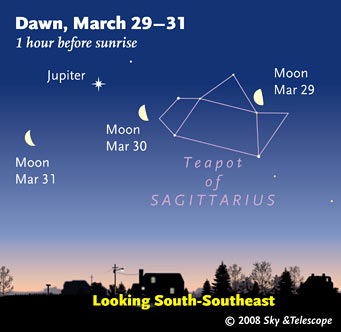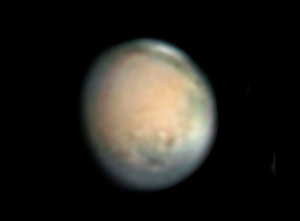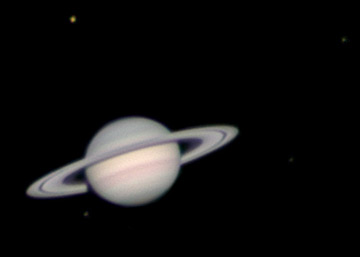Some daily events in the changing sky for March 28 – April 5.
Space Station flyovers. Every evening you can see satellites creeping across the stars. The biggest one, the International Space Station, blazes as bright as Jupiter or Venus. To see when and where to look for it, put your location and time zone into our Satellite Tracker. Also given are predictions for the Hubble Space Telescope and any space shuttle in orbit.

Watch the waning Moon skim under Jupiter from one morning to the next. This scene is drawn for the middle of North America. European observers: move each Moon symbol a quarter of the way toward the one for the previous date. For clarity, the Moon is shown three times actual size.
Sky & Telescope diagram.
Friday, March 28
Saturday, March 29
Sunday, March 30
Monday, March 31
Tuesday, April 1
Wednesday, April 2
Thursday, April 3
Find your local sunrise time by checking that your location and time zone are set in our online almanac. If you're on daylight saving time like most of North America, make sure the Daylight Saving Time box is checked.
Friday, April 4
Saturday, April 5
Want to become a better amateur astronomer? Learn your way around the constellations. They're the key to locating everything fainter and deeper to hunt with binoculars or a telescope. For an easy-to-use constellation guide covering the whole evening sky, use the big monthly foldout map in each issue of Sky & Telescope, the essential magazine of astronomy. Or download our free Getting Started in Astronomy booklet (which only has bimonthly maps).
Once you get a telescope, to put it to good use you'll need a detailed, large-scale sky atlas (set of maps; the standards are Sky Atlas 2000.0 or the smaller Pocket Sky Atlas) and good deep-sky guidebooks (such as Sky Atlas 2000.0 Companion by Strong and Sinnott, the even more detailed Night Sky Observer's Guide by Kepple and Sanner, or the enchanting though increasingly dated Burnham's Celestial Handbook). Read how to use them effectively.
More beginners' tips: "How to Start Right in Astronomy".
This Week's Planet Roundup

You can still see stuff on Mars?! Yup — if you've got a biggish scope and a good video-imaging setup. On the evening of March 24th, when Mars was only 7.4 arcseconds wide, S&T's Sean Walker made this image with his 12.5-inch reflector. He stacked hundreds of the sharpest video frames shot through red, green, and blue filters and combined them with ulfiltered luminance frames (sensitive to near-infrared, where surface features show up especially well).
North is up. Note the north polar cap and its very dark collar, and the bright evening cloud over Aurorae Sinus and Mare Erythraeum (right limb). The central meridian longitude is 106°.
S&T: Sean Walker
Mercury and Venus are buried deep in the glare of sunrise (but see April 3 above).
Mars (magnitude +0.8, in Gemini) shines in the southwest to west during evening, high over Orion. In a telescope Mars is just 7.0 arcseconds wide now — a tiny blob. A telescope will show, however, that Mars is gibbous.
Jupiter (magnitude –2.2, in eastern Sagittarius) glares in the southeast before and during dawn. The farther south you live, the higher you'll be able to observe it before dawn gets too bright.
Saturn (magnitude +0.4, near Regulus in Leo) glows high in the southeast to south during evening. Fainter Regulus (magnitude +1.4) is now just 3° from Saturn: to its right in early evening, and lower right of it later at night. Watch Saturn and Regulus draw even closer together in the coming weeks.
The two form a narrow triangle with Gamma (γ) Leonis, only a little dimmer than Regulus at magnitude +2.1, located 8° to Saturn's north.

Saturn with four of its satellites, shot on the evening of March 25th. Orange Titan is at top, Rhea is at top right, Dione is directly to Saturn's right, and Tethys is just to the planet's lower left. North is up. Scott Hammonds took the raw video frames in Florida using a Meade 10-inch Schmidt-Cassegrain telescope and a DMK 21AU04.AS camera; processing by Sean Walker.
Scott Hammonds and Sean Walker
Telescope users: there's more to see on Saturn than you may realize. See our Saturn observing guide in the April Sky & Telescope, page 66.
Uranus and Neptune are still low in the glow of dawn.
Pluto (magnitude 14.0, in northwestern Sagittarius) is well up in the south-southeast before dawn's first light.
All descriptions that relate to your horizon or zenith — including the words up, down, right, and left — are written for the world's mid-northern latitudes. Descriptions that also depend on longitude (mainly Moon positions) are for North America. Eastern Daylight Time (EDT) equals Universal Time (UT, UTC, or GMT) minus 4 hours.
To be sure you always get the current Sky at a Glance, bookmark this URL:
http://SkyandTelescope.com/observing/ataglance?1=1
If pictures fail to load, refresh the page. If they still fail to load, change the 1 at the end of the URL to another number and try again.
 0
0
Comments
You must be logged in to post a comment.